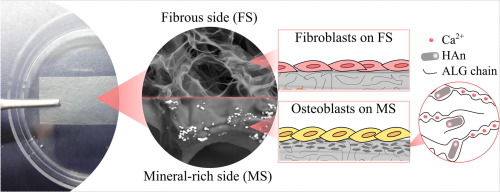当前位置:
X-MOL 学术
›
J. Colloid Interface Sci.
›
论文详情
Our official English website, www.x-mol.net, welcomes your
feedback! (Note: you will need to create a separate account there.)
Development and characterisation of bilayered periosteum-inspired composite membranes based on sodium alginate-hydroxyapatite nanoparticles.
Journal of Colloid and Interface Science ( IF 9.4 ) Pub Date : 2020-03-25 , DOI: 10.1016/j.jcis.2020.03.086 Noelia L D'Elía 1 , Ramon Rial Silva 2 , Javier Sartuqui 1 , Daniel Ercoli 3 , Juan Ruso 2 , Paula Messina 1 , Gemma Mestres 4
Journal of Colloid and Interface Science ( IF 9.4 ) Pub Date : 2020-03-25 , DOI: 10.1016/j.jcis.2020.03.086 Noelia L D'Elía 1 , Ramon Rial Silva 2 , Javier Sartuqui 1 , Daniel Ercoli 3 , Juan Ruso 2 , Paula Messina 1 , Gemma Mestres 4
Affiliation

|
BACKGROUND AND AIM
Membranes for guided bone regeneration should have a mechanical structure and a chemical composition suitable for mimicking biological structures. In this work, we pursue the development of periosteum-inspired bilayered membranes obtained by crosslinking alginate with different amounts of nanohydroxyapatite.
EXPERIMENTS
Alginate-nanohydroxyapatite interaction was studied by rheology and infrared spectroscopy measurements. The membranes were characterized regarding their tensile strength, degradation and surface morphology. Finally, cell cultures were performed on each side of the membranes.
FINDINGS
The ionic bonding between alginate polysaccharide networks and nanohydroxyapatite was proven, and had a clear effect in the strength and microstructure of the hydrogels. Distinct surface characteristics were achieved on each side of the membranes, resulting in a highly porous fibrous side and a mineral-rich side with higher roughness and lower porosity. Moreover, the effect of amount of nanohydroxyapatite was reflected in a decrease of the membranes' plasticity and an increment of degradation rate. Finally, it was proved that osteoblast-like cells proliferated and differentiated on the mineral-rich side, specially when a higher amount of nanohydroxyapatite was used, whereas fibroblasts-like cells were able to proliferate on the fibrous side. These periosteum-inspired membranes are promising biomaterials for guided tissue regeneration applications.
中文翻译:

基于藻酸钠-羟基磷灰石纳米粒子的双层骨膜启发复合膜的开发和表征。
背景和目的用于引导骨再生的膜应具有机械结构和适于模仿生物结构的化学组成。在这项工作中,我们追求开发通过将藻酸盐与不同量的纳米羟基磷灰石交联而获得的骨膜启发的双层膜。实验通过流变学和红外光谱测量研究了藻酸盐-纳米羟基磷灰石的相互作用。对膜进行拉伸强度,降解和表面形态表征。最后,在膜的每一侧进行细胞培养。研究结果证实了藻酸盐多糖网络与纳米羟基磷灰石之间的离子键合,对水凝胶的强度和微观结构具有明显的影响。在膜的每一侧都获得了独特的表面特性,从而形成了高度多孔和低孔隙率的高孔隙度纤维侧和富含矿物质的侧。此外,纳米羟基磷灰石的量的影响反映在膜的可塑性降低和降解速率增加上。最后,证明了成骨细胞样细胞在富含矿物质的一侧增殖和分化,特别是当使用大量的纳米羟基磷灰石时,而成纤维细胞样细胞能够在纤维一侧增殖。这些受骨膜启发的膜是用于引导组织再生应用的有前途的生物材料。纳米羟基磷灰石用量的影响反映在膜的可塑性降低和降解速率增加上。最后,证明了成骨样细胞在富矿物质一侧增殖和分化,特别是当使用大量的纳米羟基磷灰石时,而成纤维细胞样细胞能够在纤维一侧增殖。这些受骨膜启发的膜是用于引导组织再生应用的有前途的生物材料。纳米羟基磷灰石用量的影响反映在膜的可塑性降低和降解速率增加上。最后,证明了成骨样细胞在富矿物质一侧增殖和分化,特别是当使用大量的纳米羟基磷灰石时,而成纤维细胞样细胞能够在纤维一侧增殖。这些受骨膜启发的膜是用于引导组织再生应用的有前途的生物材料。
更新日期:2020-03-26
中文翻译:

基于藻酸钠-羟基磷灰石纳米粒子的双层骨膜启发复合膜的开发和表征。
背景和目的用于引导骨再生的膜应具有机械结构和适于模仿生物结构的化学组成。在这项工作中,我们追求开发通过将藻酸盐与不同量的纳米羟基磷灰石交联而获得的骨膜启发的双层膜。实验通过流变学和红外光谱测量研究了藻酸盐-纳米羟基磷灰石的相互作用。对膜进行拉伸强度,降解和表面形态表征。最后,在膜的每一侧进行细胞培养。研究结果证实了藻酸盐多糖网络与纳米羟基磷灰石之间的离子键合,对水凝胶的强度和微观结构具有明显的影响。在膜的每一侧都获得了独特的表面特性,从而形成了高度多孔和低孔隙率的高孔隙度纤维侧和富含矿物质的侧。此外,纳米羟基磷灰石的量的影响反映在膜的可塑性降低和降解速率增加上。最后,证明了成骨细胞样细胞在富含矿物质的一侧增殖和分化,特别是当使用大量的纳米羟基磷灰石时,而成纤维细胞样细胞能够在纤维一侧增殖。这些受骨膜启发的膜是用于引导组织再生应用的有前途的生物材料。纳米羟基磷灰石用量的影响反映在膜的可塑性降低和降解速率增加上。最后,证明了成骨样细胞在富矿物质一侧增殖和分化,特别是当使用大量的纳米羟基磷灰石时,而成纤维细胞样细胞能够在纤维一侧增殖。这些受骨膜启发的膜是用于引导组织再生应用的有前途的生物材料。纳米羟基磷灰石用量的影响反映在膜的可塑性降低和降解速率增加上。最后,证明了成骨样细胞在富矿物质一侧增殖和分化,特别是当使用大量的纳米羟基磷灰石时,而成纤维细胞样细胞能够在纤维一侧增殖。这些受骨膜启发的膜是用于引导组织再生应用的有前途的生物材料。











































 京公网安备 11010802027423号
京公网安备 11010802027423号